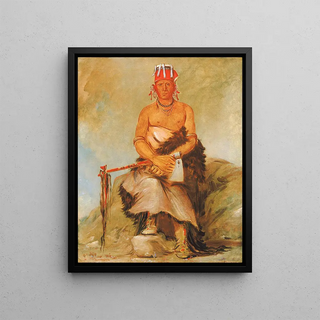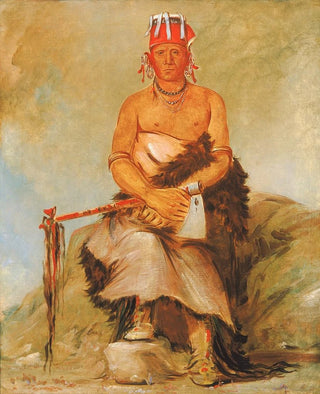Art print | Ah-Sha-La-Cots-Ah Beauty mark on the forehead Chief of the Pawnee Republican Party - George Catlin


View from behind

Frame (optional)
In the rich and complex universe of Native American art, the "Ah-Sha-La-Cots-Ah Beauty Mark on the Forehead of the Pawnee Republican Party Chief - George Catlin" stands out for its depth and authenticity. This striking depiction of a Pawnee chief, imbued with respect and sensitivity, transports us to a time when cultures met and confronted each other. Through Catlin's gaze, the artist invites us to explore the traditions and values of a people whose history is often little known. The art print of this work allows us to appreciate not only the technical virtuosity of the artist but also the importance of the stories it conveys.
Style and uniqueness of the work
Catlin's work is characterized by a blend of realism and poetry. His use of vivid colors and meticulous details gives his subjects an almost tangible life. In "Ah-Sha-La-Cots-Ah," each brushstroke seems to tell a story, with every shadow and light emphasizing the dignity of the Pawnee chief. This portrait is not limited to a simple physical representation; it captures the very essence of the cultural identity of its subject. The way Catlin manages to convey emotions and distinctive traits of this chief, while incorporating symbolic elements, demonstrates his skill in merging art and anthropology. This work is thus much more than a mere painting; it is a living testimony of a rich and vibrant culture.
The artist and his influence
George Catlin, an emblematic figure of the 19th century, dedicated his life to immortalizing Native American peoples through his art. An unwavering traveler, he journeyed across the United States to document the diversity of tribes, their customs, and ways of life. His passion for preserving these cultures, often threatened by colonial expansion, made him a pioneer in the field of visual anthropology. Catlin was able to establish a deep connection with his subjects, which is reflected in the sensitivity of his works. By placing indigenous peoples at the center of his work, he...

Matte finish

View from behind

Frame (optional)
In the rich and complex universe of Native American art, the "Ah-Sha-La-Cots-Ah Beauty Mark on the Forehead of the Pawnee Republican Party Chief - George Catlin" stands out for its depth and authenticity. This striking depiction of a Pawnee chief, imbued with respect and sensitivity, transports us to a time when cultures met and confronted each other. Through Catlin's gaze, the artist invites us to explore the traditions and values of a people whose history is often little known. The art print of this work allows us to appreciate not only the technical virtuosity of the artist but also the importance of the stories it conveys.
Style and uniqueness of the work
Catlin's work is characterized by a blend of realism and poetry. His use of vivid colors and meticulous details gives his subjects an almost tangible life. In "Ah-Sha-La-Cots-Ah," each brushstroke seems to tell a story, with every shadow and light emphasizing the dignity of the Pawnee chief. This portrait is not limited to a simple physical representation; it captures the very essence of the cultural identity of its subject. The way Catlin manages to convey emotions and distinctive traits of this chief, while incorporating symbolic elements, demonstrates his skill in merging art and anthropology. This work is thus much more than a mere painting; it is a living testimony of a rich and vibrant culture.
The artist and his influence
George Catlin, an emblematic figure of the 19th century, dedicated his life to immortalizing Native American peoples through his art. An unwavering traveler, he journeyed across the United States to document the diversity of tribes, their customs, and ways of life. His passion for preserving these cultures, often threatened by colonial expansion, made him a pioneer in the field of visual anthropology. Catlin was able to establish a deep connection with his subjects, which is reflected in the sensitivity of his works. By placing indigenous peoples at the center of his work, he...






